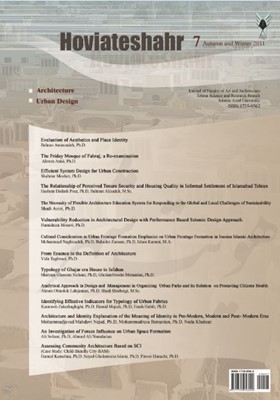The Friday Mosque of Fahraj; a Re-examination
Subject Areas : architecture
1 - Assistant Professor, Research Centre of Iranian Cultural Heritage and Tourism Organization.
Keywords:
Abstract :
For better understanding of Islamic Iranian architecture, the study of the initial Islamic era (1-5/7-12 century) is so vital. This period, owing to the transmission of the Iranian culture and civilization from the Sasanian into Islamic time, is principally known as “Transitional Period”. This progressive and continuous transition, finally have been established new Islamic culture and civilization in Iran. In these circumstances, the pre- Islamic Iranian art and architecture evolved and new themes, which were appropriate with new situation, were appeared. These new subjects were mainly inspired by pre-Islamic elements or in some cases were even emerged by borrowing them. In spite of emerging new type of building such as mosque and mausoleum, traditional elements, decoration and technique of pre- Islamic architecture, especially in their local styles, were still employed. Among other types of buildings, the mosque as the main place of worship has been the most significant Islamic building and the study of it is important for better understanding the architectural history of each period. Owing to the necessity of constructing mosque in the early Islamic centuries in Iran, they were patterned on the eminent Abbasid mosques, mainly built in the western Islamic world. However the architects attempted to illustrate the local identity by applying the Iranian architectural traditions. Among the early Islamic mosques in Iran, the Tarikhana Mosque in Damghan and the Friday mosque in Fahraj, are well-known. The latter, which is the topic of this survey, will be discussed in detail. The mosque was first introduced by Muhammad Karim Pirniya in 1969. Owing to its pre- Islamic resemblance of its decoration and architectural elements, he believed that the building is the earliest survived mosque in Iran. He did not say any specific date for constructing the building, but its date has been normally mentioned as the 1st/7th century. The mosque became the subject of later studies that carried out mainly by western scholars, who date this building not earlier than the late years of the 3rd/10th century or beginning of the 4th/11th century. This study aims to re-examine this controversial building. The main source of information has been provided by the author’s field work. In addition, the previous findings of scholars and literary texts support this research. The article highlights the architectural characteristics of the building after description of the mosque. It shows that how the dominant Arabic plan of the mosque was built in local style. The pre-Islamic elements, such as the barrel vaults and various forms of decoration were applied by local builder. The study concludes that the Friday Mosque was built in the 3rd/9th century and its attributing to the 1st/7th century is unlikely. Owing to little surviving buildings from the early Islamic Iran, the study is important on several reasons. The mosque is an authentetic example of early Islamic mosque in Iran. The colour painting on plaster of the mosque is one of the earliest examples of Islamic Iranian architecture. In addition, the architectural elements of mosque suggest the continuity of pre-Islamic style.
1 (ابن بلخی، (1363» ،(فارس نامـه»، بـه کوشـش گـای لیـسترانج و رینولـدالن
نیکلسون، چاپ دوم، تهران.
2 (ابن حوقل، (1345»،(صوره الارض»، ترجمه جعفر شعار ،تهران.
3 (استخری، ابواسحق ابراهیم، (1347» ،(مسالک و ممالک» ،بـه کوشـش ایـرج
افشار، تهران.
4 (افشار، ایرج، (1374»،(یادگارهای یزد»، ج 1 ،تهران.
5 (انیسی، علیرضا، (1385»،(تاری خانـه دردامغـان»، دایـره المعـارف بـزرگ
اسلامی، ج 14 ،تهران.
6 (پیرنیا، محمدکریم، (1349» ،(مسجد جامع فهرج»، مجلـه باسـتانشناسـی و
هنر، ش 5 .
7 (پیرنیا، محمدکریم، (1380» ،(سبک شناسـی معمـاری ایرانـی»، تـدوین
غلامحسین معماریان، تهران.
8 (جعفری، جعفربن محمدبن حسن، (1338» ،(تاریخ یزد»، (قـرن 9هجـری)، بـه
کوشش ایرج افشار، تهران.
9» (حدود العالم من المشرق الی المغـرب»، (1362 ،(بـه کوشـش منـوچهر
ستوده، تهران.
10 (ماهرالنقش، محمود، (1376» ،(معماری مسجد حکیم»، تهران.
11 (مقدسی، ابوعبداالله محمد بن احمد، (1361» ،(احسن التقاسیم فـی معرفـه
الاقالیم»، بخش دوم، ترجمه علینقی منزوی، تهران.
12 (محمدی ملایری، محمـد، (1372»،(تاریخ و فرهنگ ایران در دوره انتقال
از عصر ساسانی به عصر اسلامی»، ج 1 ،تهران.
13 (نیکزاد، ذاتاالله، (1385» ،(مجموعه کهن مـسجد جـامع میبـد»، میبـد
شهری کههست، ج 1 ،به کوشش عیسی اسفنجاری کناری، تهران.
14) Anisi, A. (2007), "Early Islamic Architecture in Iran
(637-1059)", unpublished Ph.D. dissertation, Edinburgh
University.
15) Blair, S. (1992), "The Monumental Inscriptions from
Early Islamic Iran and Transoxiana", Leiden.
16) Creswell, K.A.C (reper. 1979), "Early Muslim
Architecture", 2 vols, Londo
17) Creswell, K.A.C (reper. 1978), "The Muslim
Architecture of Egypt", 2 vols , London.
18) Ettinghausen, R., and O. Grabar (1987), "The Art and
Architecture of Islam", 650-1250, Yale.
19) Finster, B. (1994), "Frühe iranische Moscheen," Berlin.
20) Godard, A. (1934), "Le Tari Khana de Damghan",
Gazette des Beaux Arts 76, pp.225-235.
21) Shokoohy, M. (1978), "Studies in the Early Medieval
Architecture of Iran and Afghanistan", unpublished
dissertation , Herriot Watt University.
22) Zarinkoub, A. (1975), "The Arab Conquest of Iran and
its Aftermath", Cambridge History of Iran, From Arab
Invasion to the Saljuqs, vol. IV, ed. R. Frye, Cambridge.
23) Zipoli,R.and B.M.Alfieri (1977), "La Moschea Ğāmi‘ di
Fahrağ", Studi Iranici, Rome, pp 41-76.


